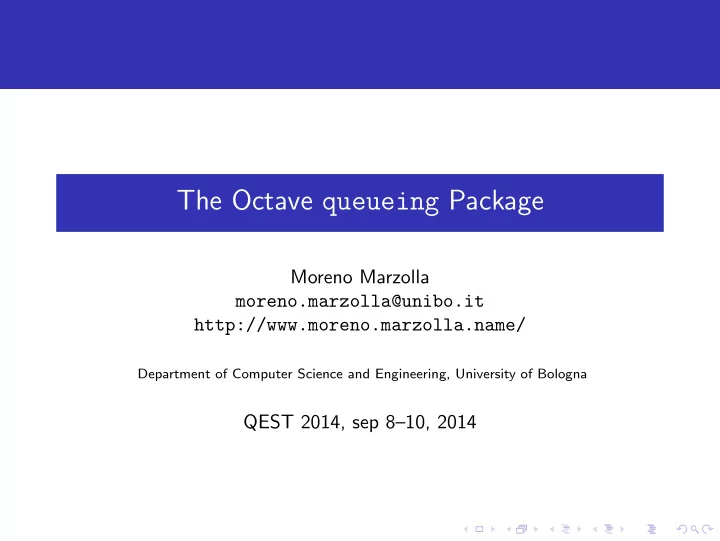

The Octave queueing Package Moreno Marzolla moreno.marzolla@unibo.it http://www.moreno.marzolla.name/ Department of Computer Science and Engineering, University of Bologna QEST 2014, sep 8–10, 2014
Outline 1 Introduction 2 A Simple Usage Example 3 Conclusions
What is queueing ? Software package for Queueing Network and Markov chain analysis Written in GNU Octave (a free Matlab clone). Contains implementation of numerical algorithms for QN and MC analysis Free software (GPLv3+) http://octave.sourceforge.net/queueing/
Functions Provided by the queueing Package Single-Station Queueing Systems M / M / 1, M / M / m , M / M / ∞ , M / M / 1 / K , M / M / m / K , ... Product-Form Queueing Networks MVA and Convolution algorithms Steady-State analysis of Open, Closed and Mixed networks Supports multiple job classes (subject to limitations for product-form) Performance bounds (Asymptotic, Balanced Job, Geometric Bounds) Discrete- and Continuous-time Markov Chains State occupancy probabilities Expected number of visits Time-averaged expected sojourn times Mean Time to Absorption First Passage Times
Why queueing ? Modeling Environment The queueing package and GNU Octave can be used for rapid prototyping and iterative refinement of QN models; parametric performance studies can be done quickly since models are defined programmatically Reference implementations The queueing package provides implementations of some common QN/MC algorithms, so that people do not have to reimplement the wheel Teaching queueing is being used in some Universities to teach performance modeling courses. Students can immediately put those algorithms at work to solve practical problems.
Limitations The Bad No support for extended QNs (blocking, priorities, fork/join, passive resources...) Efficiency and numerical stability issues with some algorithms (e.g., multiclass MVA, load-dependent service centers) The Ugly No GUI; steep learning curve since all models must be defined programmatically
Installation and Usage octave> pkg install -local -forge queueing octave> pkg load queueing octave> dtmc([0.5 0.5; 0.2 0.8]) ans = 0.28571 0.71429 octave> help dtmc -- Function File: P = dtmc (P) -- Function File: P = dtmc (P, N, P0) Compute stationary or transient state occupancy probabilities for a discrete-time Markov chain. ...
Example: Compute Farm Simple closed model of a scientific computing cluster N independent jobs process data stored in a tape library A disk cache is used to limit the access of the (slow) tapes A cache miss happens with probability 1 − p and requires to copy the data from tape to disk before the job is allowed to proceed CPUs Disk p 1 Tape 2 1 − p
Compute Farm Model Parameters CPU burst Z = 1000 s , average service time of tape S 2 = 200 s . For the same amount of money we can buy: fast disks (expensive, less disk space, lower cache hit rate), or slow disks (cheap, more disk space, higher cache hit rate). Case A: Slow disks Case B: Fast disks Disk service time S 1 = 1 s Disk service time S 1 = 0 . 9 s Cache hit rate p = 0 . 9 Cache hit rate p = 0 . 8
Compute Farm Octave code CPUs Disk p 1 Tape 2 1 − p Z = 1000; #### Scenario A: slow disks #### SA = [1 200]; p = .9; VA = qncsvisits( [p 1-p; 1 0 ] ); #### Scenario B: fast disks #### SB = [0.9 200]; p = .8; VB = qncsvisits( [p 1-p; 1 0 ] ); #### Solve models #### XA = XB = zeros(1,100); for n=1:100 [U R Q X] = qncsmva(n, SA, VA, 1, Z); XA(n) = X(1)/VA(1); [U R Q X] = qncsmva(n, SB, VB, 1, Z); XB(n) = X(1)/VB(1); endfor
Compute Farm Results 0.05 0.04 System throughput (jobs/s) 0.03 0.02 0.01 Slow Disks Fast Disks 0 0 20 40 60 80 100 Number of concurrent jobs N
Conclusions The queueing package is a collection of functions implemented in GNU Octave to analyze Markov chains and product-form Queueing Networks The queueing package is being used by researchers, practitioners and teachers to support their activity Most wanted extension: support for non product-form QNs http://octave.sourceforge.net/queueing/
Recommend
More recommend